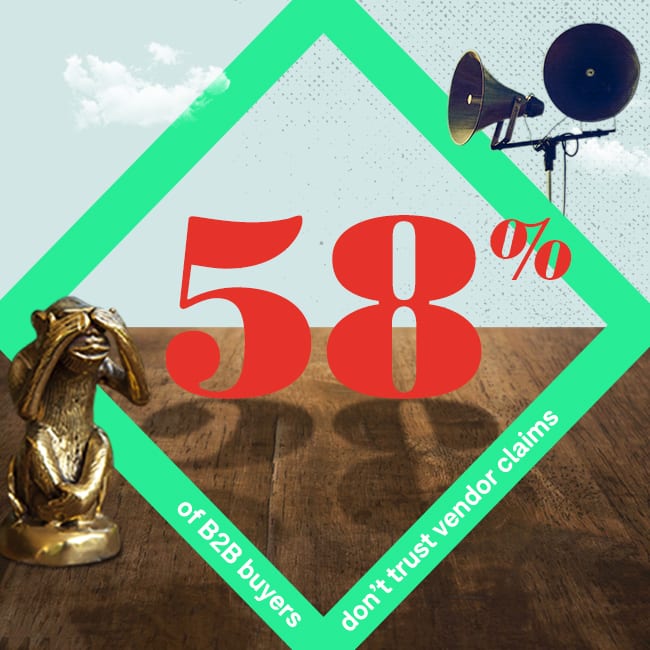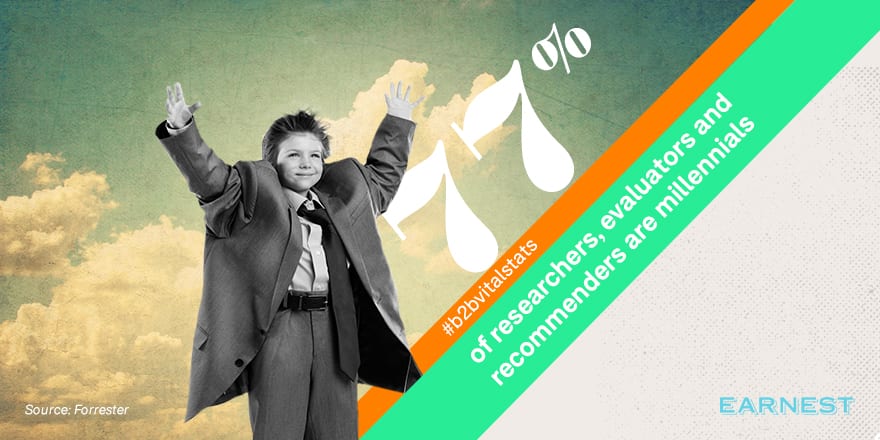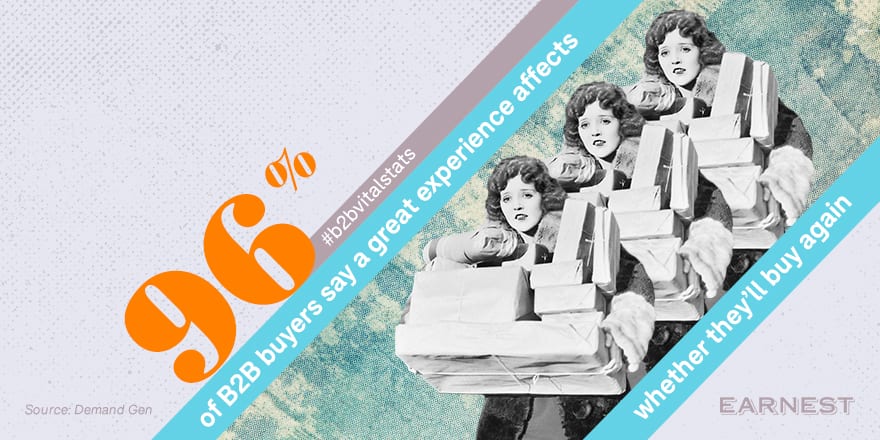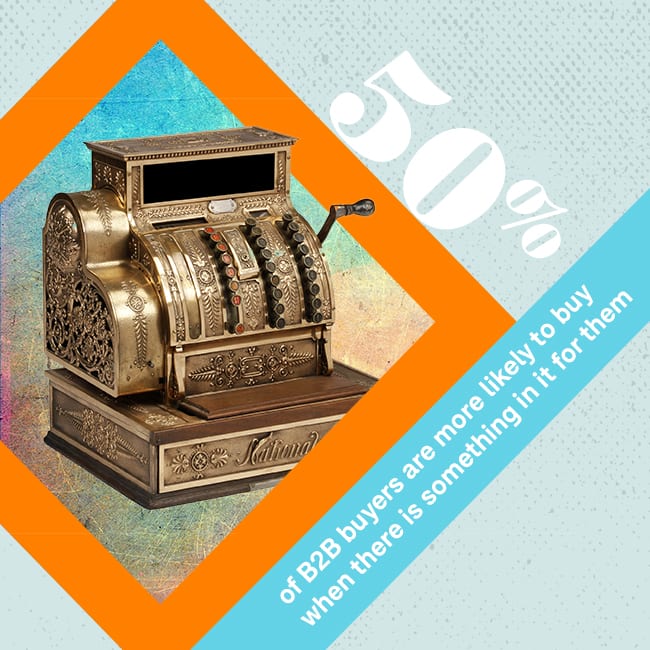The only B2B stats you’ll ever need (plus some shockers)

What are B2B buyers really thinking?
This blog – taken from our free Vital Statistics for B2B Marketers booklet – has the latest B2B buyer research rounded up into one convenient summary.
We’ve unearthed five shockers including:
- Do B2B buyers still trust brands?
- Who are the C-suite gatekeepers?
- Does CX matter that much in B2B?
- Is the role of the salesperson dead?
- Does WIFM still apply to business buyers?
So dive in, fellow fact-lovers, because nothing wins a B2B marketing argument like a killer statistic.
SHOCKER 1. Buyers don’t trust brands. Ouch.

- 58% of buyers don’t trust vendors’ claims (even those they buy from)
- 69% don’t trust ads, which may explain why the average click-through rate of an online ad is just 0.05% (that’s one click for every 2,000 views)
- 50% of business buyers say the content they receive is useless
So what’s with all the distrust and dissatisfaction? It seems like some brands have been rubbing buyers the wrong way with too much sales flannel, too many over-inflated claims, and decidedly unhelpful reps.
This is a real shame for all the brands that are doing great work but, whether or not you’ve contributed to the trust breakdown, we’re all affected by it. So what can you do to regain trust?
8 tips to bring back B2B buyer trust
1. Let people try before they buy
Nothing beats a product demo – it’s the top resource for buyers researching a product, according to the 2018 B2B Buying Disconnect Report.
2. Banish jargon
No one trusts it, everyone hates it, and it’s one of the quickest ways to lose a buyer’s interest. Or lose anyone’s interest.
3. Be open about your shortcomings
All products have flaws, so be upfront about yours. That kind of honesty will keep you on a buyer’s radar.
4. Avoid the honesty-perception gap
85% of vendors claim they’re honest about product suitability – but just 37% of buyers agree. Don’t push a sale if your product’s not right.
5. Promote user reviews
Buyers will read them anyway, so boost your credibility by showing you’ve nothing to hide.
6. Create marketing that stacks up
Buyers will cross-reference your claims so makes sure they stand up to scrutiny.
7. Ask customers to be advocates
Customer reviews hold the most sway with 64% of buyers – but only a quarter of customers are asked for a referral.
8. Harness the halo effect
Influencers and analysts hold sway over 64% of buyers, so partner with them for third-party respectability.
SHOCKER 2. Gatekeepers are getting younger.
While 64% of senior execs make the final decision on purchases, 81% of execs who influence that word aren’t senior. They’re the people who draw up the shortlists. The real string-pullers.
These are the researchers, the evaluators, the recommenders, and they have the ear of the execs and 77% of them are millennials. If you’re only targeting the C-Suite, you’re missing a trick.

Ask yourself: are you doing enough to engage these major players? Is your brand, content and salesforce speaking to them too? Because if you’re not, and you’re on their radar, chances are it’s costing you a lot of business.
How do you tune in to these C-Suite gatekeepers?
5 ways to reach the right audience
- Speak to customers
Ask how they arrived at their buying decision. Who was involved? When? Why? What went well – and what didn’t? - Analyse your data
Build profiles of who are making enquiries, downloading your content, attending industry events. Are you dismissing anyone as too junior? - Experiment with audiences
Target the broader decision-making team, not just the C-Suite. Explore different types of content and channels. Test. Learn. Optimise. - Educate sales teams
Check they don’t overlook influential audiences. Arm them with messages and content that support audiences’ different needs. - Win hearts and minds
Be the brand influencers like and respect. The most helpful. The most trusted. The one they’ll stick their neck out for.
SHOCKER 3. Customer experience really matters
Okay, so this one is no big surprise to any successful brand out there, but the stats are so compelling it’s worth reinforcing:

- 96% of buyers – that’s pretty much all of them– say customer experience directly affects whether they’ll buy again
- Customers who enjoy a great experience spend 140% more than those who don’t
- 83% of buyers will give a referral on the back of a positive experience – which is a big deal, when 84% turn to other customers for advice
Truth is, get the customer experience spot on and a buyer will be one of your biggest advocates.
But remember, buyers expect this great experience to start the moment they sign on the dotted line. Unfortunately, some brands don’t hit the ground running and friction can build, straight from the off.
No warm welcome.
No on-boarding process.
No clarity on what happens next.
And when the actual experience doesn’t match the one they were sold, buyers can feel taken for a ride. Something they won’t forget the next time they’re drawing up a shortlist.
9 ways to deliver a stellar customer experience
- Get a senior exec
An after-sale ‘thank-you’ makes a great first impression and delivers great ROI – a one-minute chat can buy months of good will. - Create personalised onboarding videos a senior exec
It shows people you value them and maintains the ‘new-customer buzz’. That first-impression thing again. - Make customer support easy
Offer things like video calls and live-chat, as well as a helpline. Tutorials help customers hit the ground running and get the most from your product. - Make customer support easy
Offer things like video calls and live-chat, as well as a helpline. Tutorials help customers hit the ground running and get the most from your product. - Run a free audit
Customers may be struggling with an easy fix or overlooking a useful feature. And who knows, you may spot an up-sell opportunity. - Give them the VIP treatment
Run customer-only events and exploit the ‘entourage effect’ by offering credits for nights out they can invite colleagues to. - Set up a customer forum
Customers can chat with peers and shape your roadmap, while you build a brand community and get valuable feedback. - Surprise and delight
Send something nice every year as a thank-you (along with a round-up of how your product’s delivered over the past 12 months). - Own their problems
Fix issues swiftly – however small – and you can turn your biggest complainers into your greatest advocates. - Offer exclusive beta versions
Get customers to sign up to early product releases – it makes them feel special and deepens brand loyalty.
SHOCKER 4. Helping is the new selling
Sales execs might not want to hear this, but 68% of B2B buyers would rather get information online than interact with them.
That’s not all: 62% of buyers rely solely on digital content to finalise their vendor list. And it gets worse: only 35% like salespeople.
Given those stats, you might assume the role of the sales rep is dead. No more. Ceased to be. B2B’s dead parrot. But not yet…because 76% of buyers still find it helpful speaking to Sales.

Because when it comes to the more complex, higher-risk purchases, buyers want help cutting through the noise – 49% are overwhelmed with the amount of content out there, while 74% feel it’s not personalised enough. Those brands that do help are handsomely rewarded:
- Vendors that make buying easy – with things like curated content and reviews – are 62% likelier than other suppliers to land a high-quality sale
- Buyers are five times more likely to engage with sales execs who offer industry insight
Turns out we’re not seeing the death of the salesman after all – we’re seeing the rebirth.
7 ways marketers can help sales to help customers
- Know the landscape
The more reps understand the issues, the greater the engagement. - Offer a compelling proposition
89% of buyers say vendors who help build a business case get their business. - Make learning easy and interesting
Create simple and engaging content to help reps impress buyers with their insight. - Retrain your reps
Play the long game – build the rapport, don’t push the sale. - Create customer-facing tools
Product selectors and ROI calculators can make your product more compelling and accelerate the buying journey. - Bolster reps’ social presence
91% of B2B buyers are on social – sharable content is a great conversation-starter. - Embrace technology
Empower reps who can’t meet in person with video conferencing tools and live-chat.
SHOCKER 5. Business buyers still make subjective decisions
Which may come as a surprise, given they’ve everything they need to research a product – from user reviews to comparison tools to check how one product stacks up against another.
But as we always say at Earnest, business people are still people. They just happen to be at work. Very few buyers evaluate all the options and make an objective decision. Why?
Time pressure for starters – when they’re against the clock, sweating on making the right call, chances are they’ll take decision-making shortcuts.
But an oft-overlooked factor is what the buyer stands to gain (or lose) from the purchase personally – they’re almost 50% more likely to buy when there’s something in it for them. Not in a nice-little-backhander kind of way, but things like getting some kudos for a wise investment.

And that’s not all – buyers are eight times more likely to pay a premium for comparable products and services when personal value is present.
So, take the time to get under your buyers’ skin – it pays to know what matters to them.
3 ways to connect better with buyers
1. Understand their goals
A buyer’s explicit goals are those your competitors probably go on about. Implicit goals are the stuff that motivates buyers personally (whether they realise it or not). Understand both: marketing’s about winning hearts and minds.

2. Know their starting point
Work out whether your offering is about enjoying a gain or avoiding loss. And remember, a proposition with a scaremongering message at its heart can easily backfire.
3. Remember buyers are different
So their motivations are different too. Identify which personas they fit, then tailor your story to meet the right implicit and explicit goals.
B2B statistics to cut out and keep
We really hope you found this blog helpful. Feel free to drop these stats into your own presentations and content. If you want to keep this somewhere safe until then, just download the booklet.
- Vital Statistics video – a quick two-minute re-cap.
- Vital Statistics SlideShare – all the stats in this blog, plus loads more.
- Vital Stats Packs – download stats by theme, ready to drop straight into your presentations, reports and social posts.
For more bite-size statistics to chew on, search Earnest vital stats.
And remember to share your own Vital Statistics on Twitter: #B2BVitalStats.
